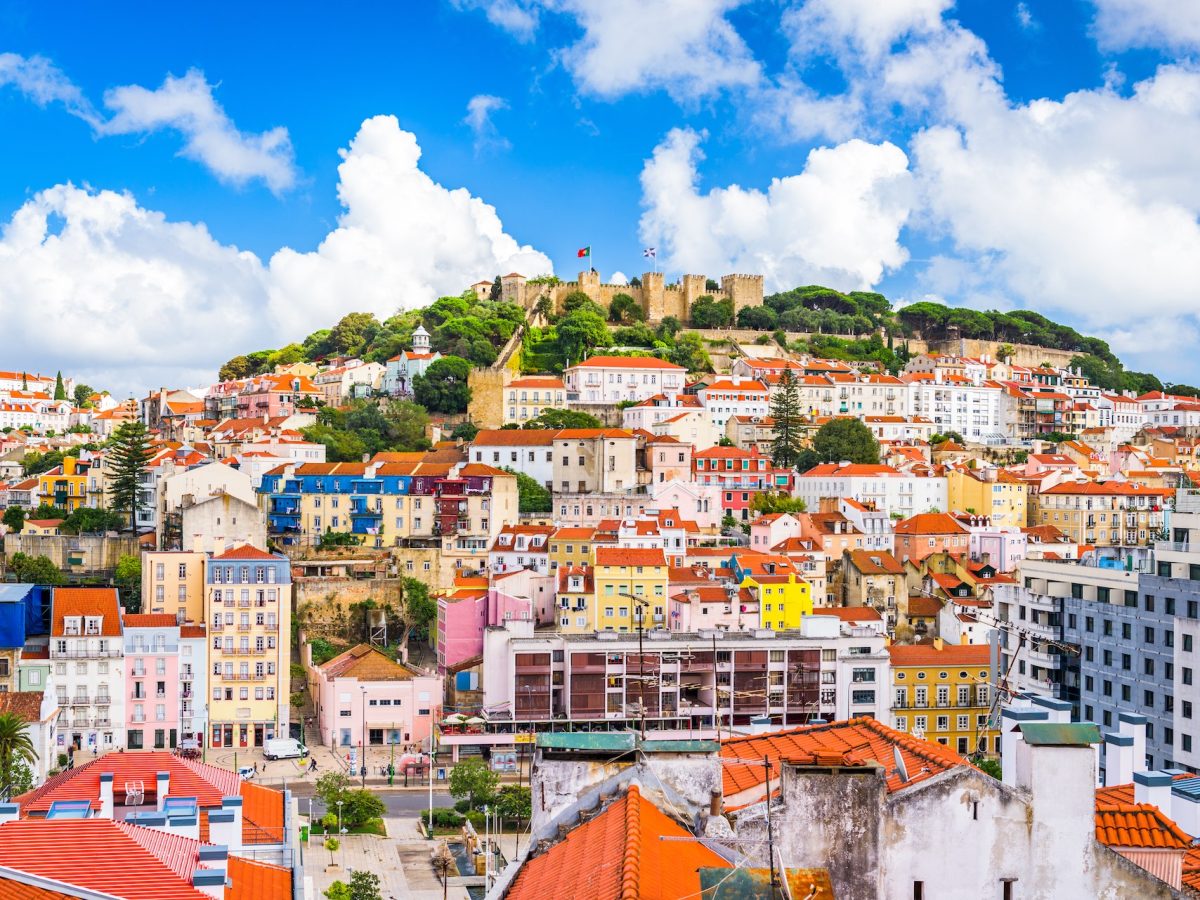Lisbon – the capital of Portugal and one of the oldest cities in Europe – enchants its visitors with a unique mix of traditional charm and modern flair. In the city of seven hills, you’ll find ancient buildings, colorful Azulejo tiles, and a Mediterranean vibe in every alley. Lisbon is also famous for Fado, the melancholic yet beautiful music style that reflects the soul of Portugal. And don’t worry: even if a street leads uphill, you’ll be instantly rewarded with a breathtaking view.
Top Attractions in Lisbon
Castelo de São Jorge
The Castelo de São Jorge sits high above the city and is one of Lisbon’s most famous landmarks. Once a royal residence, the fortress offers fascinating insights into Portugal’s history. Especially impressive is the panoramic view over Lisbon’s red-tiled rooftops and the Tagus River. If you’re feeling adventurous, you can stroll along the winding battlements and imagine life as a medieval guard.
Mosteiro dos Jerónimos
Located in the Belém district, the Jerónimos Monastery is a true masterpiece of Manueline architecture, a late Gothic style. As soon as you enter the cloister, the intricate details and historic atmosphere will captivate you. Built in the 16th century to thank the Virgin Mary for Vasco da Gama’s safe return, the Mosteiro dos Jerónimos features maritime elements as a tribute to Portugal’s glorious age of exploration.
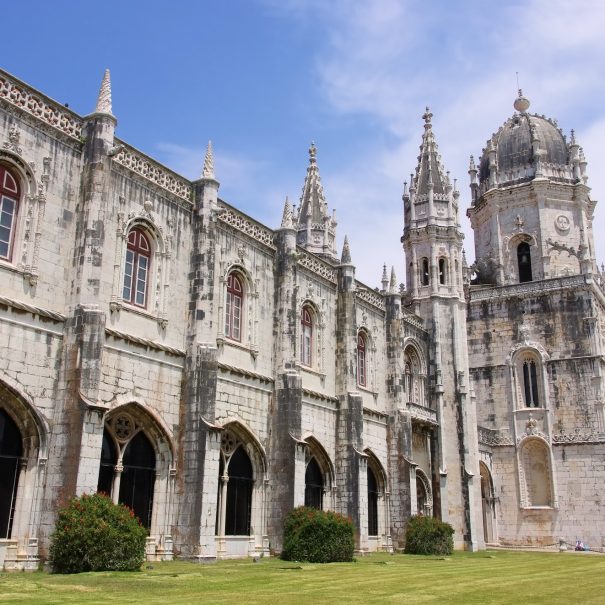
Elevador de Santa Justa
This ornate elevator, designed in a historicist style, connects the lower district of Baixa with the higher district of Chiado. The ride in the filigree cast-iron lift is an experience in itself – no need to huff and puff up steep streets. At the top, a viewing platform awaits with a fantastic panorama over Lisbon’s rooftops.
Fun Fact: The Elevador de Santa Justa was designed by a student of Gustave Eiffel – which might explain its resemblance to a miniature Eiffel Tower.
Torre de Belém
Not far from the monastery, the Torre de Belém rises directly on the Tagus River. Originally built as a defense tower, it is now one of Lisbon’s most iconic landmarks. The Manueline-style tower features richly decorated façades and bizarre stone sculptures. Since 1983, it has been a UNESCO World Heritage Site.

Cristo-Rei Statue
On the opposite side of the river in Almada, the imposing Cristo Rei statue rises 110 meters high and resembles Rio de Janeiro’s Christ the Redeemer. From the top, you’ll enjoy a spectacular view of Lisbon and the mouth of the Tagus River – the view alone makes the visit worthwhile. The statue was built in the 1950s as a gesture of thanks for Portugal being spared during World War II. To get there, take the ferry from Cais do Sodré to Cacilhas and then the bus – or rent a car.
Best Scenic Viewpoints
Miradouro de São Pedro de Alcântara
Visiting Lisbon without checking out its Miradouros is like eating Pastéis de Nata without powdered sugar – simply incomplete. The Miradouro de São Pedro de Alcântara is one of the most popular viewpoints in the city. From here, you have a stunning view of the Castelo de São Jorge and the historic center. Especially in the evening, when Lisbon is bathed in a sea of lights, the view is truly goosebump-worthy.
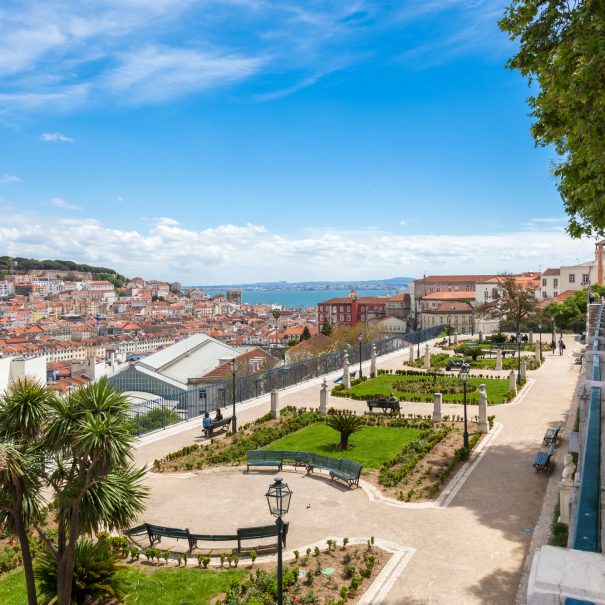
Miradouro da Senhora do Monte
Still something of a hidden gem among tourists, this viewpoint is especially loved by locals. Located on one of the city’s highest hills, it offers an almost 360-degree view over Lisbon. The climb is steep, but absolutely worth it. It’s the perfect place to watch the sunset and see the city from a bird’s-eye perspective.
Culinary Highlights for Food Lovers
Time Out Market (Mercado da Ribeira)
A paradise for foodies! The Time Out Market is home to countless stalls offering a wide range of Portuguese delicacies – from freshly prepared fish to handmade Pastéis de Nata. The market also impresses with a modern ambiance and a lively atmosphere. Grab a tray and dive into the culinary variety. Overwhelmed by the options? Let your nose guide you – or follow the loudest market vendor. Sometimes the most charismatic one will even share a secret recipe!
A Cevicheria
This spot is all about Peruvian-Portuguese fusion cuisine – with a strong focus on ceviche. Chef Kiko Martins has created a place that impresses both in flavor and design: a giant octopus hanging from the ceiling above the bar is definitely worth a photo or two. The place is popular, so it’s best to come early or be prepared to wait.
Cervejaria Ramiro
For seafood lovers, Cervejaria Ramiro is the place to be. For generations, shrimp, clams, and lobster have been grilled, steamed, and served to perfection here. A true taste experience for anyone who loves fresh fish. And if you’re vegetarian, you can at least enjoy the atmosphere – or treat yourself at one of the many other restaurants in the city afterward.

Discover 70+ cities worldwide with professional audio guides – and counting! Thanks to integrated navigation, you’ll easily find your way, even without an internet connection. Whether it’s famous highlights or hidden gems – Plazes brings exciting tours and vivid stories straight to your smartphone. Completely free and no registration required. Download now and get started!
Insider Tips & Hidden Gems
LX Factory
Once a textile factory, this space has evolved into a creative hotspot in recent years. Artists, designers, and restaurateurs have transformed it into an urban mecca worth exploring. From street art to boutiques and cozy cafés and bars – LX Factory is a place where you can wander for hours and constantly discover something new.
Jardim do Torel
This garden is a real oasis in Lisbon’s bustling center. Tucked away on a hillside, it invites you to linger with shady benches and a relaxing atmosphere. While the view isn’t as dramatic as from the official Miradouros, it’s far quieter here. A great place to read a book or escape the hustle and bustle. Just be prepared to climb some steep stairs – but at the top, a picturesque scene awaits, perfect for your Instagram feed!
Museums for Culture and History Enthusiasts
Museu Nacional do Azulejo
The National Azulejo Museum is a must for anyone who loves Lisbon’s iconic tiles. You’ll learn everything about Portugal’s centuries-old tile-making tradition and admire stunning exhibits ranging from the 15th century to today. The museum itself is housed in a former monastery – so the architecture is just as impressive as the exhibition.
Fun Fact: Azulejos were originally introduced from the Arab world. Portugal turned them into an art form that covers entire façades. It’s said that there are about 50 different shades of blue used in these typical tile patterns!

Museu Coleção Berardo
Fans of modern and contemporary art should definitely visit the Museu Coleção Berardo in Belém. Here, you’ll find works by Picasso, Dalí, Warhol, and many more. The exhibition is organized by theme and offers an exciting overview of the major art movements of the 20th century.
Museu do Fado
Since Fado is such an integral part of Lisbon, a museum dedicated to this musical tradition is practically a must. The Fado Museum showcases how this melancholic-romantic sound emerged in the taverns of Alfama and how it has endured to this day. Audio stations, films, and exhibits immerse you in the world of Fado – goosebumps guaranteed.
Photospots in Lisbon
Rua da Bica de Duarte Belo
This narrow street with its historic tram tracks is one of the most photographed locations in Lisbon. When the famous “Ascensor da Bica”, a nostalgic tram, slowly rattles past you, the moment is postcard-perfect. With colorful houses in the background and a view down to the Tagus, every shot becomes a highlight.
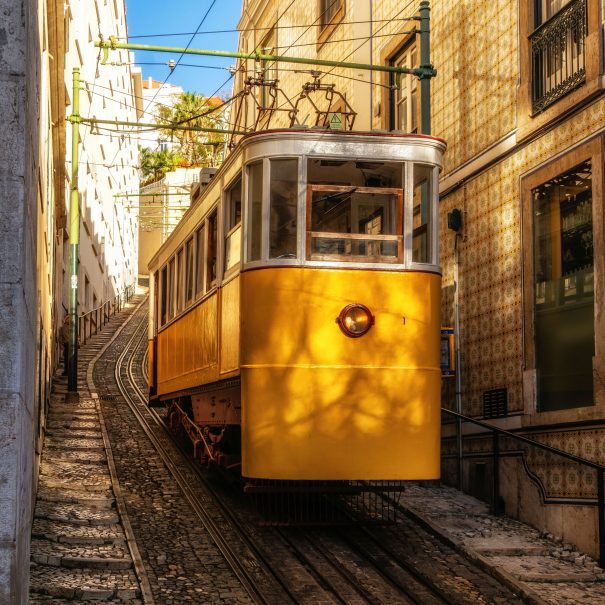
Arco da Rua Augusta
The imposing triumphal arch at Praça do Comércio marks the entrance to Baixa, the heart of Lisbon. From the viewing platform on top of the arch, you’ll enjoy a fantastic view over the expansive square and the river. Photographers especially love the symmetrical lines and the interplay of light and shadow. A snapshot from the ground with the arch in full view? Definitely an Instagram moment.
Shopping & Souvenirs
In Lisbon, souvenir hunters will be spoilt for choice with colorful Azulejos, handmade ceramics, and delicious Pastéis de Nata. Whether in the small alleys of Alfama, the elegant Chiado district, or the trendy shops of LX Factory – everywhere you’ll find lovingly crafted items that will remind you of your trip. For a special memento, check out traditional cork products (like bags or wallets), as Portugal is one of the world’s top cork producers.
The iconic canned sardines aren’t just a tasty souvenir – their retro design makes them real eye-catchers. If you’re into fashion, head to Rua Augusta and the surrounding streets, where international brands mingle with local Portuguese designers. And between shopping sprees, you’ll always find a café where you can enjoy a Bica (Portuguese espresso).
Tips for Cruise Passengers
Lisbon is a popular cruise destination with a modern terminal in Santa Apolónia, right on the edge of the Alfama district. This means you can step right into the historic heart of the city after docking.
Many attractions like the Sé Cathedral or Castelo de São Jorge are within a 15–20-minute walk (though uphill in parts). Lisbon also has a well-developed network of buses, trams, and a metro. A day pass is worth it after just a few rides. Taxis and Ubers are also widely available. Prices are moderate compared to many other European capitals.
If you’re planning a trip to nearby Sintra or the coastal town of Cascais, renting a car might be a good idea. But be aware of heavy city traffic. If you’re nervous about Portuguese driving skills, it’s better to hop on a tram. It may not have seatbelts – but at least it won’t suddenly change direction!
Tips for Solo Travelers
Lisbon is an incredibly friendly city for solo travelers. The Portuguese are generally open and helpful, and the city feels very safe. Hostels and guesthouses are great places to meet like-minded people. Thanks to the excellent public transportation network, even distant districts are easy to reach.
You’ll find tourist info points at Praça do Comércio or Rossio station, offering maps, brochures, and event tips. As a solo traveler, consider attending a Fado night or joining a Pastéis de Nata cooking class – it’s not only fun, but also a great way to meet fellow travelers. More information is available on the official tourist website: https://www.visitlisboa.com/en .
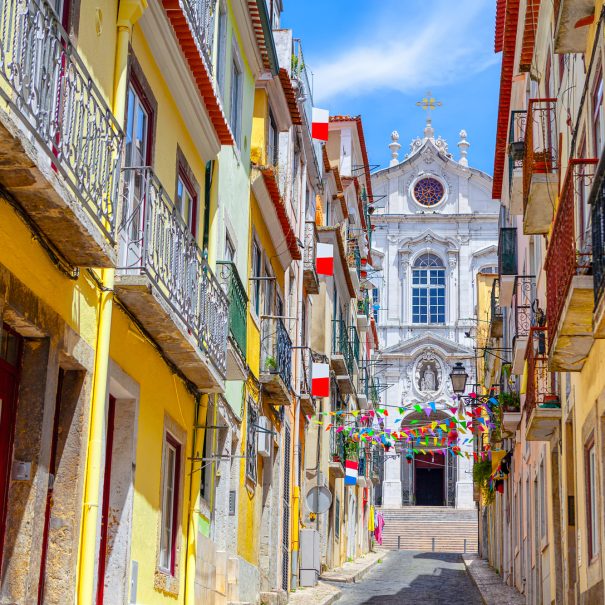
Conclusion
Lisbon is a city that inspires on every level: historic buildings meet modern street art, vibrant neighborhoods meet peaceful Miradouros with breathtaking panoramic views. Whether it’s your first visit or your fifth, you’ll always discover new corners and experiences in Lisbon. From magnificent sights for history buffs to top-notch culinary spots, from idyllic gardens to trendy creative hubs – this metropolis has something for every taste.
And don’t worry about the famous hills: with a bit of endurance or a ride on a historic tram or elevator, you’ll quickly be rewarded – with views that will take your breath away. So pack your comfiest shoes, don’t forget your camera, and get ready for the Lisbon adventure!
FAQs
1. Which neighborhoods in Lisbon are must-visits beyond the classic tourist attractions?
In addition to the well-known areas like Alfama and Baixa, Bairro Alto and Chiado are very popular for their vibrant nightlife, trendy cafés, and boutiques. If you prefer a quieter atmosphere, consider a detour to Belém to visit the Jerónimos Monastery or the Belém Tower.
2. Can Lisbon be explored in one day when arriving from the cruise port?
A day trip is enough to get a first impression and see some of the main sights in the historic center. For example, you can visit the Sé Cathedral and the Castelo de São Jorge and enjoy lunch in Baixa. However, for a more in-depth experience – such as visiting museums or attending a Fado concert – at least two to three days are recommended.
3. Do you need to buy tickets in advance for major attractions like the Belém Tower?
Especially during peak season (spring and summer), long queues are common. Online tickets or combination passes (e.g., for the monastery and tower together) often offer the advantage of faster entry. For popular museums like the National Azulejo Museum, advance reservations can also be helpful, though they are not always strictly necessary.
4. What is the best time of year to visit Lisbon?
Lisbon is a great destination year-round. Summer can be very hot and crowded with tourists. Spring (March to May) and fall (September to November) offer more pleasant temperatures and fewer crowds. Winter is mild, though rainy days can occur – but you’ll often benefit from lower accommodation prices.
5. How accessible is the city for people with limited mobility or strollers?
The city is known for its many hills, narrow alleys, and cobblestone streets, which can pose challenges for people with limited mobility or those using strollers. Nevertheless, there are elevators like the Elevador de Santa Justa and escalators at some viewpoints. Many museums and attractions have accessible entrances. It’s advisable to research in advance, for example through the tourist information center or the websites of individual providers.

